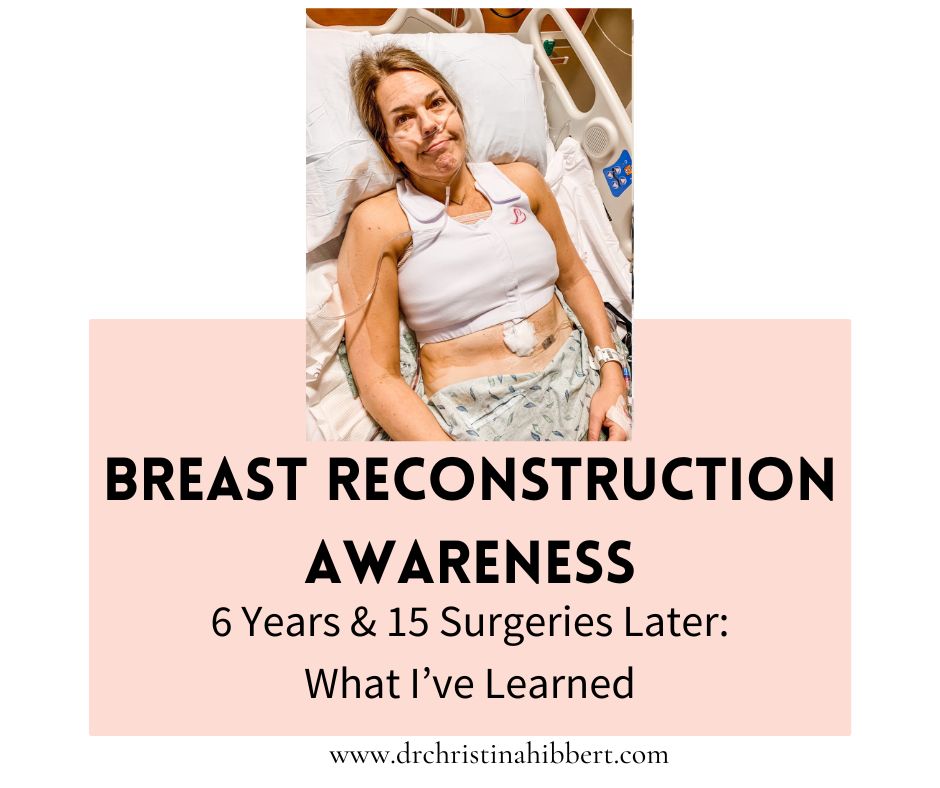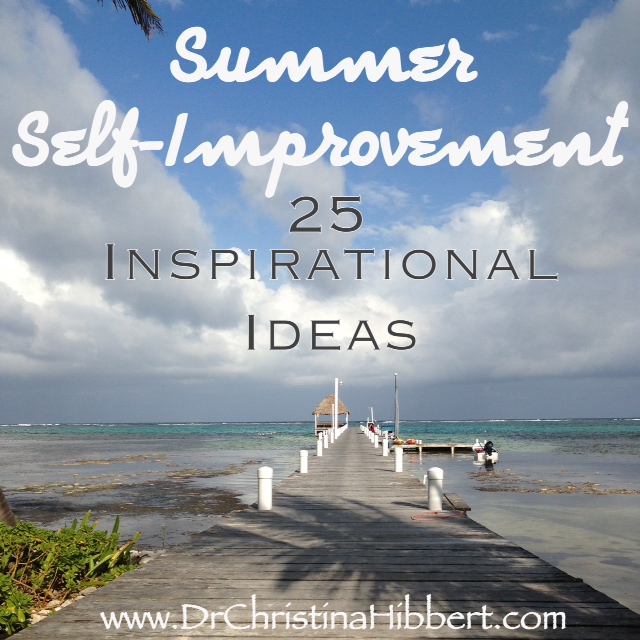By Dr. Christina Hibbert
Updated for BRA Day 2025 – Breast Reconstruction Awareness Day
Six Years, Fifteen Surgeries, and a Lifetime of Lessons
When I was first diagnosed with breast cancer in July 2019, I thought reconstruction would be the easy part—the finish line after the shock, the chemo, the mastectomy. It seemed simple enough: double mastectomy, expanders, implants, done.
Little did I know that I would one day count 15 surgeries—a looping, painful, bewildering, and ultimately clarifying journey through infection, rejection, implant illness, hernias, mesh removal, and finally, a hard-won kind of peace with my body that I’m just beginning to comprehend.
I write this now, six years later, not from the place of someone “done” with cancer, but as a woman who has been rebuilding herself—physically, emotionally, and spiritually—again and again.
What BRA Day Really Means
You might not have heard of Breast Reconstruction Awareness (BRA) Day before. It began as an effort by the American Society of Plastic Surgeons and The Plastic Surgery Foundation to “educate, engage, and empower women to make the decision that is best for them following a diagnosis of breast cancer.”
Their reminder that “the breast cancer loop remains open until a woman is informed of her reconstruction options” has always resonated deeply with me.
Because for six years, I’ve lived inside that loop—a cycle of de-construction and reconstruction that has taught me just how incomplete the “standard” conversation around reconstruction can be.
The Timeline of Reconstruction: My Fifteen Surgeries
I often wish I had seen a story like mine when I was newly diagnosed. Maybe I wouldn’t have felt so alone when everything kept going wrong.
1. July 24, 2019 — Double Mastectomy with Expander Placement
One week after diagnosis. I was still in shock. My surgeon, Dr. Beth Dupree, performed a nipple-sparing mastectomy with expanders placed immediately.
2-3. September 12, 2019 — Exchange to Implants + Full Hysterectomy
I thought I could “get it all done” at once due to my BRCA1 mutation. I woke up believing the worst was over.
4-5. September–December 2019 — Multiple Infections and Implant Removals
Staph infection → right implant removed.
Chemo weakened my system & caused infection → left implant removed.
By Christmas 2019, I was flat, scarred, and exhausted.
6. March 2020–Kidney Stones.
Chemo left me with kidney stones which I had removed right as COVID began.
7–9. May–June 2020 — Re-Attempt with Expanders and Implants
We tried again. Within days, another infection.
Antibiotic beads, emergency surgery, IV antibiotics.
Miraculously, we saved one implant—but my body was telling me, no more foreign devices.

10. September 18, 2020 — DIEP Flap Reconstruction
A nine-hour microsurgery transferring tissue from my abdomen to create new breasts. The most complex surgery yet—but it felt like a step toward wholeness.
11. September 19, 2020 — Emergency Surgery for Post-Op Bleeding
A drain burst; my abdomen filled with blood. Back to the OR within 24 hours.
12. September 25, 2020 — Emergency Hernia Repair
One week later, an ambulance ride to Scottsdale. My intestines had shifted through the incision. Another surgery, another hospital stay. I woke to find they’d placed hernia mesh in me. I’d just gotten my implants out for making me sick!

13. 2020 — Fat Grafting to “Fix” DIEP Breast Reconstruction
An “easier” surgery, and I thought it would be my last.
14. 2022 — Hernia Mesh Removal
The mesh used to repair my hernia caused intense pain, inflammation, and rejection. More surgery followed to remove the mesh and repair the abdominal damage using skin from my back.
15. 2023 — Abdominal Repair
Procedure to repair tissue damage, tighten skin used in abdominal repair, reduce scar tissue, and restore mobility. Each surgery left new scars—and new lessons in surrender.

How My Feelings Have Changed
At first, I believed reconstruction would restore what I’d lost. Now I know it’s not about restoration—it’s about redefinition. (Read my original BRA Day article from 2020)
Breast cancer and treatment broke me down to nothing. And Breast Reconstruction didn’t just rebuild my chest; it forced me to rebuild my identity, my expectations, and my relationship with my body.
I no longer see my scars as evidence of something broken; they are maps of survival.
But that acceptance wasn’t instant. There were years I felt angry—betrayed by my body, misunderstood by doctors, alienated from a culture that praises “bouncing back.”
Even now, with chronic illness layered on top of cancer recovery, I still wrestle with pain and fatigue. Yet, I’ve learned that healing isn’t about returning to who I was—it’s about growing into who I am now.
What I’ve Learned (And What I Hope You Know Too)
1. You Deserve a Choice
To reconstruct or not is your decision—and yours alone.
It’s okay to say no to implants. It’s okay to stay flat. It’s okay to change your mind halfway through.
Every woman should be presented with all viable options from the start—implants, expanders, flap procedures, or no reconstruction at all.
2. Information Is Empowerment
The breast cancer loop stays open until you’re fully informed.
Ask questions. Research procedures. Talk to other survivors.
I wish I’d known earlier about DIEP flap, about mesh complications, about the potential for Breast Implant Illness.
When we know better, we choose better—for our unique bodies.
3. Sometimes the Right Choice Emerges Through Hard Lessons
I wouldn’t wish my infections or implant failures on anyone.
But those painful experiences revealed the truth my body already knew: I needed a natural reconstruction.
Sometimes, clarity only comes through trial, error, and surrender.
4. No Two Journeys Are the Same
Even with the same procedure, every woman heals differently.
Some will recover quickly and move on. Others, like me, will face years of complications and unexpected diagnoses like POTS, MCAS, and EDS.
There is no “right” way to reconstruct. There is only your way.
5. Healing Takes Time—and Tenderness
Breast reconstruction isn’t an event; it’s a long process of grieving, rebuilding, and integrating.
Be gentle with yourself. Rest. Let your body lead.
The emotional and physical healing are inseparable—both require patience, compassion, and faith.
6 Years and 15 surgeries later…
I no longer see reconstruction as something that happened to me. It’s something I lived through—and continue to live with.
My reconstructed body is not a replacement for what I lost; it’s a testament to how deeply I’ve learned to love the woman I’m becoming
 Get My Free Guide: The Breast Cancer Emotional Survival Guide
Get My Free Guide: The Breast Cancer Emotional Survival Guide
If you’re walking your own path through diagnosis, treatment, or reconstruction, I created this guide to help you heal emotionally while navigating the medical and physical realities of breast cancer.
I’m working on a book I hope will be helpful, too. You can subscribe for updates and early access below.
You’re not alone in this. We may each heal differently—but we can grow through what we go through, together.



